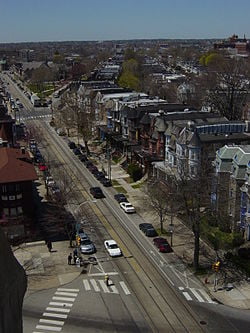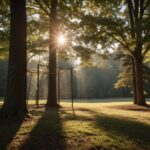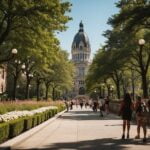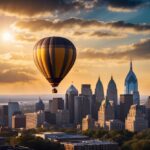West Philadelphia, also known as “West Philly,” is a diverse and vibrant area of Philadelphia known for its unique architecture, bustling cultural scene, and rich history. This part of the city, stretching from the Schuylkill River to the western suburbs, is a melting pot of cultures, traditions, and experiences. From the grand Victorian homes of University City to the murals that colorfully narrate the city’s history, West Philadelphia is a testament to the City of Brotherly Love’s rich and varied tapestry.
This area is home to several distinct neighborhoods, each boasting its unique identity and charm. West Philadelphia’s history is as varied as its neighborhoods, painting a vivid picture of the city’s growth over the centuries. The demographics of West Philadelphia reflect the diversity that defines Philadelphia, with a mix of cultures, races, and ethnicities living side by side. Each neighborhood, street, and building in West Philadelphia has a story to tell, making it a captivating area to explore.
Neighborhoods
West Philadelphia is composed of a myriad of neighborhoods, each possessing its own unique character and sense of community. It’s an area that perfectly encapsulates the multicultural, historical, and architectural diversity that characterizes the City of Brotherly Love.
Belmont
Belmont is a West Philadelphia neighborhood steeped in history. Named after the Belmont Mansion, a stately house built in the 18th century, the neighborhood itself is filled with a mix of row houses and stand-alone homes. The streets are dotted with mature trees and local parks, creating a relaxed suburban ambiance.
This neighborhood offers its residents a sense of tranquility with the nearby Fairmount Park providing plenty of outdoor space. The sprawling urban green park is a hub for recreational activities including hiking, cycling, and picnicking. The Belmont Plateau within the park offers a fantastic skyline view of Philadelphia, a favorite spot among locals.
Belmont’s close-knit community atmosphere adds to its appeal. Neighborhood associations and local volunteers are active in community improvement projects, and events like block parties and yard sales foster a strong sense of camaraderie. The rich history, relaxed atmosphere, and active community make Belmont a vibrant and comfortable place to call home.
Belmont Village
Adjacent to Belmont is Belmont Village, a neighborhood that shares its larger neighbor’s charm and ambiance. This quiet residential enclave is characterized by its charming brick homes, neatly lined along tree-covered streets. The community vibe is warm and inviting, with neighbors often seen chatting over their fences or during a leisurely stroll.
Belmont Village enjoys a desirable location, with easy access to Philadelphia’s city center as well as the expansive Fairmount Park. This blend of suburban tranquility and urban convenience makes the neighborhood a sought-after location for many. The local public schools and safe streets also make it a popular choice for families.
Although it is one of the smaller neighborhoods in West Philadelphia, Belmont Village more than makes up for its size with its strong sense of community. It embodies the notion of being a “small town within a big city.” Local initiatives and events, like the annual block party, reinforce the close-knit community spirit that distinguishes Belmont Village.
Carroll Park
Carroll Park, named after the local park that shares its name, is a vibrant neighborhood located in West Philadelphia. Known for its stunning brick row homes dating back to the early 20th century, Carroll Park retains a historical charm that blends seamlessly with the area’s urban energy. The neighborhood is diverse, with a blend of residents from various cultural and socio-economic backgrounds.
The neighborhood is closely-knit, with active community organizations that work tirelessly to foster a sense of unity and pride among residents. From organizing local events to encouraging beautification projects, these community initiatives have fostered a strong communal spirit in Carroll Park.
The neighborhood’s close proximity to downtown Philadelphia, coupled with its robust community spirit and historic charm, make Carroll Park an attractive residential area. It encapsulates the spirit of West Philadelphia — a fusion of the historic and contemporary, with a community that is as diverse as it is united.
Cedar Park
Cedar Park, another gem in West Philadelphia, is best known for its dynamic art scene, lively street festivals, and the eponymous park. This neighborhood is a haven for artists and creative minds, which is reflected in its eclectic local shops, art galleries, and mural-adorned buildings.
A significant feature of Cedar Park is its beautiful Victorian twin houses. These architectural beauties line the neighborhood’s streets, exuding an old-world charm that stands in interesting contrast to the modern lifestyle the area provides. The community itself is diverse and close-knit, with residents deeply involved in neighborhood development and cultural activities.
Cedar Park’s distinctive personality is defined by its vibrant art scene, historical architecture, and strong community spirit. Its diversity and cultural richness, coupled with the tranquility of the beautiful Cedar Park, make it an attractive neighborhood to both singles and families alike.
Centennial District
Centennial District, located in West Philadelphia, is named after the 1876 Centennial Exposition held in the area. This neighborhood is uniquely positioned as it is home to the Philadelphia Zoo and the Please Touch Museum, both of which are located within the scenic Fairmount Park.
The neighborhood itself is largely residential with a mix of row homes, single-family homes, and apartments. It provides a quiet, suburban feel within the city. The residential areas are well-kept and the community is closely knit, with a neighborhood association dedicated to maintaining the area’s quality of life.
Centennial District, with its historical significance, tranquil suburban atmosphere, and cultural landmarks, provides a unique living experience. Whether it’s a day at the zoo, a jog in Fairmount Park, or a community gathering, there’s always something to do in this vibrant neighborhood.
Cobbs Creek
Cobbs Creek is a neighborhood named after the waterway that forms its western boundary. It’s a culturally diverse neighborhood with a rich history and a strong sense of community. The area is primarily residential with tree-lined streets and a range of housing from row homes to large, standalone houses.
Cobbs Creek Park, the neighborhood’s namesake, is a significant feature of this community. The park has numerous hiking and biking trails, picnic areas, and a large playground. The Cobbs Creek Environmental Center is also located here and offers various environmental education programs.
Cobbs Creek has an active community organization that hosts events and initiatives, further promoting the neighborhood’s sense of community. With its scenic beauty, strong community, and diverse residential options, Cobbs Creek offers a unique slice of life in West Philadelphia.
Dunlap
Dunlap, a small residential enclave in West Philadelphia, offers residents a unique fusion of city and suburban life. This tight-knit community is characterized by its rowhomes and Victorian twin houses, reflecting the architectural styles that are emblematic of Philadelphia.
The neighborhood’s sense of community is enhanced by its engaged and active residents. Local organizations frequently host community events, and neighbors know each other by name, making Dunlap a welcoming and friendly place to live. Additionally, Dunlap’s proximity to the larger Overbrook neighborhood offers easy access to amenities and recreational opportunities, adding to its appeal.
Despite its small size, Dunlap holds a unique appeal, offering a quiet, close-knit living experience. Its distinctive blend of city and suburban life, coupled with a strong sense of community, make it a charming place to call home.
Garden Court
Garden Court, located in the western part of University City, is a historic neighborhood known for its eclectic mix of architectural styles, ranging from Victorian mansions to modern apartment buildings. This architectural diversity contributes to the area’s unique and vibrant character.
This neighborhood is known for its active community life. The Garden Court Community Association hosts events such as the annual chili cook-off and progressive dinner, fostering a sense of community among residents. The neighborhood’s tree-lined streets and namesake park also contribute to its charm and livability.
While Garden Court is primarily residential, it’s also within walking distance of a variety of restaurants and shops in University City. Combining historic charm, a vibrant community, and urban convenience, Garden Court embodies the best of West Philadelphia living.
Haddington
Located in the western part of the city, Haddington is a historic neighborhood with a diverse and growing community. It’s renowned for its classic row houses, reflecting the neighborhood’s development during the late 19th and early 20th centuries.
Haddington is a vibrant and dynamic neighborhood with a strong community spirit. Locals frequently come together for neighborhood cleanups, block parties, and community gardening. In addition, Haddington is home to several community arts organizations, adding to the neighborhood’s cultural vibrancy.
Despite the urban bustle, green spaces like the Haddington Woods and Carroll Park offer residents places for recreation and relaxation. With its rich history, active community, and access to green spaces, Haddington offers a unique living experience in West Philadelphia.
Haverford North
Haverford North is a dynamic neighborhood in West Philadelphia, best known for its unique blend of residential spaces, commercial establishments, and public parks. Its row homes are an iconic feature of the neighborhood, a testament to the city’s architectural history.
Living in Haverford North provides residents with a genuine feel of community spirit. The neighborhood is home to a diverse group of people who take pride in their community, organizing regular social and cultural events. Haverford North is also home to the Shepard Recreation Center, a lively hub that offers a wide range of recreational activities for both children and adults.
A key feature of Haverford North is its close proximity to the city’s bustling center, offering residents quick and easy access to a host of amenities and services. Its unique blend of community feel, convenience, and the characteristic charm of West Philadelphia make Haverford North a desirable place to live.
Mantua
Mantua is a neighborhood rich in history and cultural heritage. It’s primarily residential, with most homes being row houses. The neighborhood’s long history is evident in its varied architectural styles, representing different eras in the city’s development.
The community in Mantua is closely-knit, with residents actively participating in local initiatives and organizations. The neighborhood’s community garden and the annual Mantua Arts Festival are testaments to this. The festival showcases local talent and attracts visitors from across the city, highlighting Mantua’s vibrant arts scene.
Mantua’s location, near some of Philadelphia’s major institutions like Drexel University and the Philadelphia Zoo, adds to its appeal. The neighborhood’s rich history, strong community spirit, and strategic location make it a unique part of West Philadelphia.
Mill Creek
Named after the now covered waterway that once flowed through it, Mill Creek is a neighborhood in West Philadelphia with a rich history and a strong sense of community. Predominantly residential, the neighborhood is characterized by its rows of brick homes and quiet streets.
Mill Creek’s residents take pride in their community, fostering a tight-knit neighborhood spirit. This is showcased through various community-led initiatives and programs aimed at neighborhood improvement and youth development. The Mill Creek Urban Farm, for instance, is a local landmark that provides educational programs and grows fresh produce for the community.
Despite its urban setting, Mill Creek offers ample green space for residents to enjoy, including several playgrounds and recreation centers. With its community spirit, urban farm, and accessible amenities, Mill Creek provides a unique living experience in West Philadelphia.
Overbrook
Overbrook, a neighborhood located on the western edge of Philadelphia, is known for its historic residential architecture and leafy, tree-lined streets. Its houses, many of which are stone or brick single-family homes, exude an old-world charm that adds to the neighborhood’s appeal.
The community spirit in Overbrook is vibrant and active. Residents take pride in their neighborhood, leading to a strong network of community organizations and initiatives. Overbrook is home to several schools and religious institutions, contributing to its family-friendly environment. Its well-maintained parks and recreational areas, such as Tustin Playground and Morris Park, provide excellent spaces for outdoor activities.
In terms of amenities, Overbrook boasts a good selection of local businesses, restaurants, and services. The neighborhood’s convenient location, close to the heart of Philadelphia and easily accessible by public transportation, makes it an attractive place to live. The charm, community spirit, and convenience combine to make Overbrook a standout neighborhood in West Philadelphia.
Overbrook Park
Overbrook Park is a quaint residential neighborhood in the western section of Philadelphia. Known for its well-maintained single-family homes and townhouses, the neighborhood offers a suburban feel within the city. The architectural style is predominantly mid-century, giving the neighborhood a distinctive character.
Overbrook Park boasts a strong sense of community. The Overbrook Park Civic Association actively organizes events and initiatives to maintain the neighborhood’s vibrancy and appeal. Its well-maintained green spaces, such as Rose Playground and Morris Park, provide residents with opportunities for outdoor activities and contribute to the neighborhood’s serene ambience.
The neighborhood also offers easy access to shopping and dining options, both within the area and in nearby neighborhoods. With its tranquil residential character, strong community, and convenient location, Overbrook Park provides a unique living experience within West Philadelphia.
Overbrook Farms
Overbrook Farms is a historic neighborhood in West Philadelphia, known for its grand homes and lush green spaces. Its distinctive architectural style, with many homes dating back to the late 19th and early 20th centuries, gives the neighborhood a distinct, old-world charm.
The neighborhood is home to a vibrant community that cherishes its historical roots. The Overbrook Farms Club, a resident-led organization, works to preserve the neighborhood’s historic character and foster a sense of community. The neighborhood also hosts an annual house tour that showcases its unique architecture and rich history.
Overbrook Farms is conveniently located, with easy access to Center City Philadelphia and the Main Line suburbs. The neighborhood’s historic charm, vibrant community, and strategic location make it a unique part of West Philadelphia.
Parkside
Parkside is an eclectic neighborhood in West Philadelphia known for its rich history and architectural heritage. Its residential streets are lined with Victorian-style homes that evoke an old-world charm. The neighborhood is also home to several historic sites, such as the Parkside Historic District, which adds to its unique character.
The neighborhood offers a tight-knit community spirit, hosting numerous events, especially in Fairmount Park, one of the largest urban park systems in the country. This park’s presence not only adds to the natural beauty of the area but also makes it a hub for outdoor recreational activities, providing venues for picnicking, jogging, and biking.
Parkside’s location offers easy access to numerous amenities, including restaurants, shops, and cultural institutions. Its proximity to the Philadelphia Zoo and Please Touch Museum makes it a family-friendly neighborhood. Overall, Parkside provides a charming and vibrant living experience that resonates with the historic soul of Philadelphia.
Powelton Village
Powelton Village, located in the University City area of West Philadelphia, is known for its Victorian-era houses and tree-lined streets. The neighborhood is a harmonious blend of history and modernity, where the old architectural charm coexists with the youthful vibe of university students.
This neighborhood boasts a diverse community that contributes to its vibrant culture. Many community-driven events and initiatives happen throughout the year, creating a strong sense of belonging among residents. The neighborhood is also known for its commitment to sustainable living, hosting an annual “Green Day” to promote eco-friendly practices.
With a wide array of restaurants, shops, and art galleries, Powelton Village offers an eclectic mix of experiences for its residents and visitors. Its proximity to Drexel University and the University of Pennsylvania adds to the neighborhood’s appeal. Powelton Village truly embodies the dynamic and diverse spirit of West Philadelphia.
Saunders Park
Saunders Park, a small neighborhood in West Philadelphia, is a residential community known for its green spaces and easy access to amenities. The neighborhood is named after Saunders Park Greene, a small green space that provides a gathering spot for residents and hosts community events.
Despite its small size, Saunders Park has a tight-knit community spirit that is evident in its active civic association. The neighborhood’s streets are lined with a mix of traditional Philadelphia row homes and apartment buildings, contributing to its urban residential appeal.
Saunders Park’s location, adjacent to Powelton Village and University City, provides residents with access to a wealth of dining, shopping, and entertainment options. The neighborhood’s friendly community, green spaces, and convenient location make it a unique part of West Philadelphia.
Spruce Hill
Spruce Hill in West Philadelphia is known for its diverse community, historic homes, and rich cultural life. The neighborhood is a blend of students, academics, and professionals, thanks to its proximity to the University of Pennsylvania. The Victorian-style houses and tree-lined streets lend an old-world charm to this neighborhood.
Spruce Hill is home to Clark Park, a local hub of activity hosting year-round events including a farmers’ market, Shakespeare in the Park performances, and the annual May Fair. This public space contributes to the community’s strong sense of cohesion and camaraderie.
The neighborhood also boasts a variety of dining and shopping options, featuring eateries and shops that reflect the community’s diversity. This, along with its active neighborhood association and excellent schools, makes Spruce Hill an attractive place to live in West Philadelphia.
Squirrel Hill
Not to be confused with the neighborhood of the same name in Pittsburgh, Philadelphia’s Squirrel Hill is a small, quiet community in West Philadelphia. It’s characterized by modest row houses, narrow streets, and a close-knit community.
Despite its size, Squirrel Hill provides an attractive residential setting. The neighborhood’s tranquility is complemented by its accessibility to amenities in nearby neighborhoods, making it a best-of-both-worlds location for those seeking peaceful urban living.
The community spirit in Squirrel Hill is vibrant. Neighbors are known to collaborate on various initiatives, from street cleanups to block parties, further enhancing its appeal as a friendly, welcoming neighborhood.
University City
University City, aptly named for housing two of Philadelphia’s largest universities – University of Pennsylvania and Drexel University, is a lively and vibrant neighborhood. Its student-centric atmosphere contributes to the area’s dynamic energy, and its diversity is reflected in everything from the eclectic architectural styles to the range of dining options.
The neighborhood is known for its cultural institutions, including the Institute of Contemporary Art and the Penn Museum. It is also home to numerous startups and tech companies, making it a hub of innovation and entrepreneurship.
University City is characterized by green spaces like Clark Park and Penn Park, offering residents an urban environment with a touch of nature. With its blend of academia, culture, and community, University City provides a unique living experience in West Philadelphia.
Walnut Hill
Walnut Hill, located in West Philadelphia, is a neighborhood that stands out for its blend of residential and commercial districts. The area is home to a diverse mix of residents, and its proximity to University City lends it a youthful vibrancy.
The residential streets are lined with well-maintained row houses, and the neighborhood’s commercial corridors offer an assortment of restaurants, shops, and services. In addition to its urban amenities, Walnut Hill is also home to several parks that provide a touch of greenery amidst the cityscape.
Walnut Hill Community Association actively works towards improving the quality of life in the neighborhood, making it a safe, clean, and pleasant place to live. With its active community, vibrant commercial district, and diverse population, Walnut Hill offers a unique residential experience in West Philadelphia.
Woodland Terrace
Woodland Terrace is a historic neighborhood within West Philadelphia known for its distinctive architecture. Its streets are lined with homes designed by renowned architect Samuel Sloan in the mid-19th century. These historic homes, characterized by their Victorian Gothic style, give the neighborhood its distinctive character and charm.
Apart from its architecture, Woodland Terrace is also known for its close-knit community. Residents come together for various neighborhood events and initiatives, fostering a sense of belonging and camaraderie. This strong community spirit makes Woodland Terrace a pleasant and welcoming place to live.
Situated near the University of Pennsylvania, Woodland Terrace also benefits from the dynamism and amenities associated with a university town. Its unique architecture, combined with its vibrant community and convenient location, make it a desirable neighborhood in West Philadelphia.
Wynnefield
Wynnefield, sometimes referred to as “The Field,” is a diverse, dynamic neighborhood located in the West Philadelphia region. Known for its strong sense of community and historic homes, Wynnefield offers a unique living experience within the bustling cityscape.
The neighborhood features a range of housing options, including quaint row houses, stately stone homes, and modern apartment buildings, attracting a diverse mix of residents. The area is characterized by tree-lined streets and is conveniently located near Fairmount Park, one of the largest urban green spaces in the country, offering residents a multitude of recreational opportunities.
Wynnefield’s cultural diversity is reflected in its variety of food and entertainment offerings. It’s also home to several educational institutions, including Saint Joseph’s University, adding to the neighborhood’s vibrant atmosphere. Overall, Wynnefield offers a robust community experience with a distinct character and charm that sets it apart in West Philadelphia.
Wynnefield Heights
Wynnefield Heights, a residential neighborhood located in the northwest part of West Philadelphia, is known for its suburban-like feel within the city limits. Its location atop a hill gives many of its homes picturesque views of the Philadelphia skyline.
The neighborhood offers a mix of housing options, from single-family homes to apartment complexes. This, combined with its peaceful atmosphere and its green spaces, make Wynnefield Heights a desirable location for families and those seeking a quiet urban living experience.
Wynnefield Heights is also home to several medical and educational institutions, including the Philadelphia College of Osteopathic Medicine. Its proximity to City Line Avenue provides easy access to shopping and dining, and its closeness to Fairmount Park offers plenty of recreational opportunities, enhancing the overall quality of life in the neighborhood.
History
West Philadelphia’s history is deeply intertwined with the growth and development of the city of Philadelphia itself. Originally farmland and country estates in the 17th and 18th centuries, West Philadelphia started to urbanize in the early 19th century, mainly because of the construction of the Market Street Bridge in 1805, and later the introduction of streetcar lines. Some of the earliest suburbs of Philadelphia were developed here, and these were often designed around the concept of the streetcar suburb, with houses built along the new trolley lines that stretched from Center City.
The late 19th and early 20th centuries saw a period of significant growth as grand Victorian-style homes were built in many West Philadelphia neighborhoods. The area became a center for African American culture in Philadelphia, especially in areas like Belmont and Mantua, with a flourishing of music, literature, and art in the early 20th century. Post World War II saw some decline in the area, but starting in the late 20th century, many neighborhoods in West Philadelphia have seen significant revitalization and gentrification, with areas such as University City and Powelton Village becoming vibrant, diverse neighborhoods filled with students, academics, and young professionals.
West Philadelphia’s 20th-century history is marked by considerable socioeconomic change, driven largely by population shifts, industrial decline, and urban renewal efforts. The area was initially characterized by a mix of upper- and middle-class neighborhoods. However, as the city industrialized, many wealthier residents began moving to the newly developing suburbs. This left a void that was filled by working-class families and immigrants, creating a mosaic of distinct and diverse communities within West Philadelphia.
The area’s more recent history, particularly since the late 20th century, has been defined by its relationship with institutions such as the University of Pennsylvania and Drexel University. Their development plans have sparked revitalization but also controversy over gentrification and displacement. Despite these challenges, West Philadelphia continues to be a thriving part of the city, known for its cultural, racial, and economic diversity. The resilience and adaptability of its residents have been crucial in shaping its rich history and will continue to influence its evolving narrative.
Demographics
West Philadelphia’s population is as diverse as its neighborhoods, with a mix of students, professionals, artists, and families. The area is known for its racial and ethnic diversity, with a significant African American population as well as growing Asian and Hispanic communities.
Notable Features
West Philadelphia is teeming with notable features that make it unique and worthy of exploration. At the top of the list is its abundance of green spaces, including the verdant expanse of Fairmount Park. One of the largest urban parks in the country, it offers a myriad of recreational opportunities, from hiking and biking to fishing and birdwatching. Another exceptional natural space is the University of Pennsylvania’s BioPond, a hidden gem within the bustling city where visitors can immerse themselves in a serene, beautifully landscaped habitat.
An undeniable highlight of West Philadelphia is its cultural and educational institutions. The area is home to the University of Pennsylvania and Drexel University, which not only contribute to the region’s intellectual vibrancy but also offer architectural beauty. The Please Touch Museum, a haven for children, and the Philadelphia Zoo, the oldest in the country, are located here too. In addition, there are numerous historic sites, such as the Belmont Mansion, which sheds light on the African American experience in the early days of the United States.
The area also boasts a unique and eclectic mix of architectural styles, from Victorian-era homes in Cedar Park to the contemporary, art-inspired buildings in University City. In fact, West Philadelphia’s ‘University City’ is considered one of the most architecturally diverse neighborhoods in America. The commercial corridors, such as 52nd Street (known as West Philly’s Main Street) and Baltimore Avenue, offer a variety of shops, restaurants, and arts venues, reflecting the area’s diverse cultural influences. These notable features contribute to the distinct character of West Philadelphia, making it a dynamic part of the larger City of Brotherly Love.
Conclusion
West Philadelphia, with its diverse neighborhoods, rich history, and unique features, offers a unique perspective of the City of Brotherly Love. From the bustling streets of University City to the quiet, tree-lined avenues of Powelton Village, there’s something for everyone in West Philadelphia.
For a broader perspective on the city’s culture, history, and neighborhoods, be sure to explore our comprehensive guide, “Discovering Philadelphia: A Comprehensive Guide to the City of Brotherly Love.” This resource provides an in-depth look into the essence of Philadelphia, offering a closer look at the city’s countless attractions and unique characteristics.






8 thoughts on “Unveiling West Philadelphia: A Deep Dive into Its History, Neighborhoods, and Unique Features”